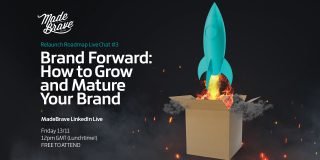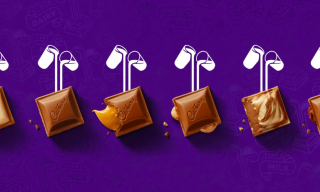You’ll have heard us talk about humanising your brand before, but what if we told you that brands follow human-like life stages too? In order to stay relevant and reach their full potential, brands need to become more responsive and take on more responsibility as they grow and mature through each life stage.
No, this isn’t an H. G. Wells warning that brands will soon become sentient and displace all life as we know it, but when you look at how brands progress, it bears a startling resemblance to our own personal experiences as people muddling through life: forming our first words, getting an embarrassing spot on prom night, or noticing that first grey hair in the mirror.
Just like real life, brands need to stretch and grow and develop over time. Each phase is necessary, so don’t feel disheartened if you haven’t made it all the way into brand adulthood yet. You can’t run before you can walk—or crawl for that matter.
The Terrible Twos

You have a beautiful new brand baby, mazel tov! Your brand is in its infancy and, by its very nature, is immature. In the early stages, you take baby steps to formalise yourself into something tangible, frequently focusing on the look alone. While a logo and a set of brand guidelines are obviously important, it isn’t the be-all and end-all of your brand (sorry designers, please don’t throw your toys out the pram).
Gone are the days of Mad Men. No longer are we dealing with one big campaign and relying heavily on an aesthetically pleasing piece of print. While a visually pleasing look may initially grab consumers’ attention, brands that linger here and fail to take on more substance risk losing their audience to competitors who do.
During the early years, most businesses are in survival mode. The main focus is keeping your team fed and the bills paid as you toddle through the trials of starting a new business. At this point, most brands don’t have the time, money, and resource to think about the nuances of their ambitions and how they’re going to affect the big, wide, world around them. And that’s okay—they’ve only just arrived after all.
Growing Pains
During adolescence, brands begin to establish their own personality and identity. It’s right about now that some can be prone to experiencing a sort of teenage existential crisis as they start to build a narrative that will later feed into their sense of purpose in the world (and by “purpose” we mean something more meaningful than just making money). Later in life, they might refer to this narrative as their ‘brand story’ making sure to preface each segment with the classic “back in my day…” *shakes fist* opener.

Once you have a purpose in mind, it’s time to become a rebel with a cause by setting a clear vision for the future, and starting to shout about some your aspirations, even if you’re not 100% sure how you’re going to get there. It’s also a great time to start writing out a focused set of values that will dictate your brand’s behaviour and working culture.
As people become familiar with your values, they’ll look to see if your actual behaviour reflects what you say you represent. Consistency is key at this point. Practice what you preach—people are paying attention and it’s much easier to lose the trust of your tribe than it is to gain it back!
The Cappuccino Years
So you have a distinctive look and feel, a well-defined purpose, and a set of values to boot. Being in “survival mode” is nothing more than a distant memory from your formative years, so you now have all the time and resource you need to tackle some of the more audacious plans you’ve been dreaming about. Welcome to brand maturity.
In your earlier years, you didn’t want to get older. You loved the exciting times, the unknowns, and the adventure! What nobody told you was that having an assured sense of self and a plethora of life experiences could not only be fun but also give you greater confidence and the ability to take the right, most rewarding risks.
At this point, your brand is thicker skinned, can ignore any baseless criticism, and absorb the constructive critique to better yourself. You know exactly where you’re headed next, and you know which rules to follow or break to get you there.
When people ask you how you made it this far, you’re sure to tell them it didn’t happen by accident. You got here by setting goals, planning, and measuring your success on a regular basis. In brand speak, this means you have something more robust than what might be written on the back of a napkin—you have a comprehensive brand strategy in place to help guide you toward your wider business objectives.
There is, of course, the temptation to rest on your laurels, pull out the comfy extendable chair and flick through the figurative photo album of past successes, but this is a recipe for early retirement. This is how brands lose their edge, their momentum and ultimately, their relevance.
The truth is that branding is never done! If you want to stay connected with your audience, staying flexible and adaptable is your fountain of youth.
Staying flexible with age
In case you hadn’t noticed, us humans are an adaptable bunch and your brand should be, too. In a world where culture fluctuates rapidly and social concerns are more prevalent than ever, brands that want to stay relevant need to be more responsive than ever. Add to that the ever-increasing amount of content brands need to create for mediums that change day-to-day, and it’s safe to say brands have their work cut out for them.
Phew! Sounds stressful we know, but there are ways to stay flexible without rewriting your brand strategy every 15 minutes—like using content to prototype, test, and evolve your brand. In other words, sticking to a rigid brand strategy simply won’t do. Like any halfway-decent tray of rice crispy treats, you need a solid structure with plenty of gooey flexibility baked in.

So, which brands are doing it right?
Nike’s 2018 ‘Dream Crazy’ campaign is a well-known case study for how mature brands can stay relevant. Though the move initially caused a backlash, the brand actually saw a sizeable spike in sales following the launch of the campaign. But Nike didn’t make this decision on a whim—they had a brand strategy in place that helped them decide how to react. This is the perfect example of a mature brand taking one of the “rewarding risks” we talked about earlier (‘member that?).
30 years ago Patagonia stated they would “build the best product, cause no unnecessary harm, use business to inspire and implement solutions to the environmental crisis” which they have continued to demonstrate over the years. They even have a dedicated activism page to keep customers up to date on their latest endeavours. In this case, they’re not even waiting to see what culture will do next—they’re leading from the front. Popular culture has finally caught up to Patagonia’s brand purpose and now they’re reaping the benefits.
Since Ben and Jerry’s changed their mission statement in the late 80s to “prioritize progressive values, especially equality and sustainability”, they have demonstrated their brand purpose in many ways:
- The peace Pop in 1988, protesting nuclear weapons funding while children were in poverty
- Flavours like ‘Justice Remix’d’ to support criminal justice reform, and most recently
- Ben and Jerry’s took a very clear stance on BLM. They didn’t mince their words when they declared “We must dismantle white supremacy”. Their long-standing brand values have allowed them to adapt to current issues while remaining genuine in their actions

Staying true to yourself
While flexibility may be a decent slice of the brand relevance pie, it’s important to point out that mature brands don’t just automatically go with the flow.
Think of it this way—when you were younger, you were still figuring out who you were. For some, it started with saying things like “yeah man, totally” all the time. Others might have started wearing band t-shirts on the daily while others of us were up way past our bedtimes rebelliously reading marketing strategy blogs under the covers (just us?). But now that you’re all grown up you realise that some of those things were the real you (🤘 because Metallica is life 🤘) while other things, well, weren’t, so you shed the fluff, take responsibility for your impact on the world, and start to focus on the things and people in your life that really matter.
Great brands are like that. As their potential for impacting the world grows (think power, profit, and the ubiquity of their offering) they start to divert more time and energy and effort into making their mark on the world. They do this not just because of a trending hashtag on Twitter but because impacting the world for good is the reason they get out of bed in the morning—and it always has been.
Want to explore this a bit further? Check out our recent Linkedin Live:
How we can help you
Our dedicated team of business and brand strategists can use research and insights to ensure we leverage the strongest components of your business and identify the best opportunities to grow and mature your brand.




